Ingrown nail, frequent recurrent disease
Qu’est-ce qu’un ongle incarné : C’est une plaie que fait un fragment d’ongle qui pénètre dans la peau qui l’entoure et qui est plus ou moins inflammatoire et plus ou moins infecté et se manifeste par une rougeur, une douleur et un écoulement plus ou moins séreux et purulent. Cela concerne le plus souvent l’ongle du gros orteil. L’incarnation pouvant être latérale ou antérieure.
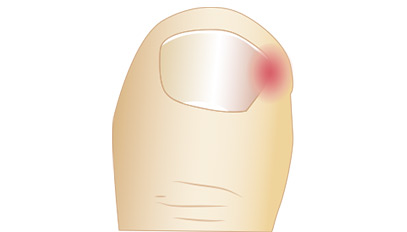
Structure of the nail
The nail is a structure dedicated to the protection of a part of the body: The nails have little of calcium, the hardness comes from the histological structure and its chemical composition. 3 layers: A superficial layer formed by the death of cells that come from the matrix. These cells lose their nuclei and accumulate fibrous protein material such as the keratins that form the fibrous web and other amorphous inter fibrous materials. An intermediate layer is thicker, with the same origin as the superficial layer but with sharp cells and a deep layer.
Around an incarnated nail, we find:
- Hypertrophy of the lateral bead, with gradual increase in the perimeter of the digital pulp of G.O.
- Formation of a fleshy bud, infected reddish, botryomycome, or pyogenic granulome.
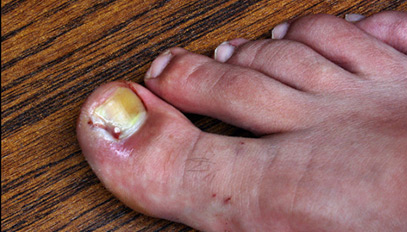
Causes of the Incarnation of the Nail
- Poorly fitting shoes with too narrow shoes
- Defects or defective pedicure care by cutting too short and too curved
- Trauma, with nail growth towards the pulpit,
- Defects determined with hereditary character this is called dystrophies.
- More rarely:
- Some treatments for Psoriasis or certain antiretrovirals (PIs);
- Some forms of osteoarthritis that affect and disrupt the growth of the tablet.
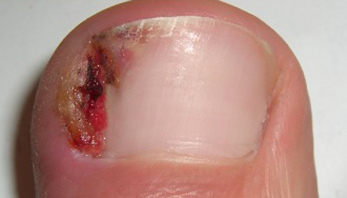
Reminders on the nail
The nail is a flattened blade that protects the fingers. With several layers, formed of keratin, it rests on the epidermal bed and has 4 edges: 2 lateral edges in the lateral furrows with epidermal folds. – The distal edge and the free edge of the nail. On the proximal edge, under the fold of the epidermis is the tablet, also called the “matrix”, which is the original part of the nail. It also participates in the production of the nail ( its renewal and growth). It is pink in color and farther white is called the “lunula”. The skin fold called nail has two surfaces: dorsal and palmar or ventral. The horny layers of the two faces form an expansion called “cuticle” and has the function of protecting the nail. The nails are an extension of the skin and a kind of a substitute for the skin, the keratin continues the epidermis. The percentage of water makes the difference: 85% v / s 12%.
INGROWN NAIL
Additional information
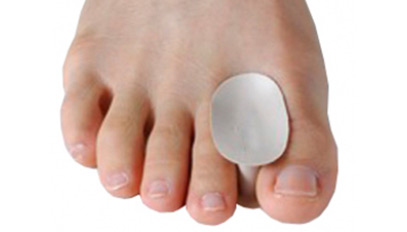
Conservative medical treatment?
The treatment is primarily medical and is mainly oriented towards local treatment combined with hygiene and common sense measures: (there is a very high risk of recurrence of the ingrown nail) certain forms that are rebellious to any treatment:
- Local care: Antiseptic treatment, dressings to be done in good aseptic conditions, it is better to do the first with a professional graduate nurse – to learn and then do the dressings yourself in a clean manner;
- NSAIDs: Anti-Inflammatory Derivatives Non-Steroidal cortisone),
- Analgesics (painkillers) in general, combined with Fitting (wearing a half-size shoe Wider, more flexible),
- Initial local antibiotic therapy, or parenteral Oral) in the event of persistence of infectious signs,
- Orthoplastics or toe separator,
- Local hygiene care: hygiene means, how to cut the nail and avoid artificially creating a conflict between the nail and the skin.
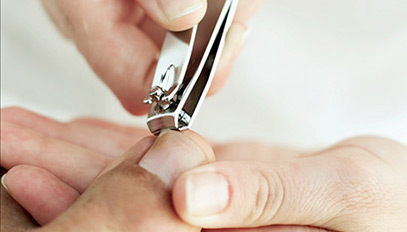
Surgical treatment?
After failure of the medical treatment, a surgical gesture may prove to be indispensable. What does it consist on?
a-Simple:
It involves one or two gestures. The first one is a resection of the incarnated part, an operation called Partial Onychectomy, the other one associates with the 1st, is a partial resection of the tablet and its sterilization with either the scalpel (recurrence in more than 15 to 20% of cases) Either the electric scalpel, or Laser or with Phenol (Phenolization), the rate of recurrence is then less (5 to 10%).
b- In case of multiple recidivism:
Associated with a gesture on the soft parts: wide resection of the bead + or – associated with a skin digital plasty of the finger pulp, by a what is usually called a “shark mouth” incision.
TERMINOLOGIE
- Hypertrophy of the bead: excess of skin formed near the furrow para nail
- Hallomegaly: Big voluminous toe, especially in Egyptian foot
- Hallux phalangeal: deviation of the distal phalanx towards the outside, comes to put the Big Toe in conflict the second toe
- Nail dystrophy: Nail in the form of a “U”, or a “tile”, also known as « clamp »
- Tablet of the nail: also called matrix, is at the base of the growth and regeneration of the nail.
- Onychomycosis: mycotic or fungal nail infection
- Melanoma of the nail: a tumor revealed by a brown spot under the nail
- Toe Separator: Avoids conflict between the 1st and 2nd toes
- Orthoplasty: a custom-made separator by the podiatrist.
- Digital pulp surgery: reduces the perimeter of the pulp in order to reduce the volume of the great toe , reducing the risk of conflict between the 1st and 2nd toes,
